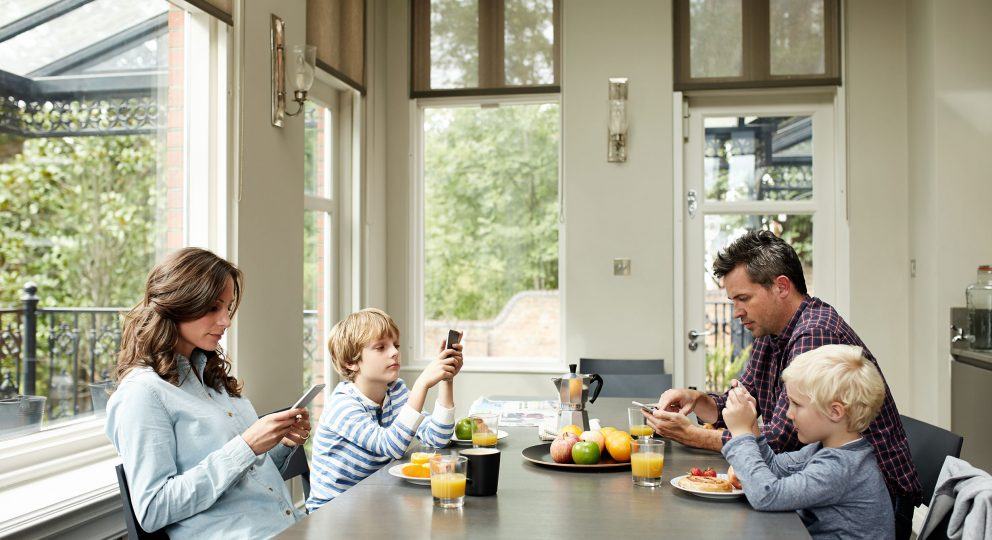Personal devices are changing the way couples and families interact. In our clinical experience, almost every couple who seeks help is conflicted about the role technology plays in their lives. It’s especially true for families with young children and teens.
We were recently asked by ABC News to consult for their two-hour special report, ScreenTime: Diane Sawyer Reporting, about families struggling with this very situation. As part of the program, we observed a number of different families, but one stood out. They are a loving family with two working parents and four children, ranging from pre-teen to college age. The ironic thing was that the youngest child reached out, saying that his family needed help.
The news crew set up cameras in their home to help the family understand the actual amount of time that they spent on phones, tablets, or laptops. Looking at an average Saturday, the times varied from over four hours to almost eight hours per person. Every family member was shocked by the amount of time they were investing in their screens.
One poignant moment in the interview with the family was when they watched old home movies of their family life before everyone had a smartphone. They all talked about missing the fun they had playing together outside. The laughter in the videos was infectious.
In contrast, a video of a scene from their current life showed the entire family sitting in the living room practically silent. Every member of the family was engrossed in their own device. Few, if any, words were exchanged. The family dog wandered from person to person attempting to get some attention without much success. It was easy to see why the youngest child asked for help.
We had a chance to talk with the parents and two of the children. We offered them the suggestions for change below, which they seemed to take to heart.
Have a weekly family meeting
Schedule a weekly family meeting to set screen time limits that seem fair to everyone. And use the meetings to evaluate how those agreements are working out. In the Gottman Method, we encourage couples to have a weekly State of the Union meeting. You can do the same thing in your family.
Allow everyone to weigh in on the conversation
While it is the parents’ responsibility to ultimately set the limits, children often respond best when they have a voice in the conversation about what is important to them.
Agree on some simple things
Begin small and perhaps agree to have some time when everyone is to be without phones or screens, such as family dinner.
Make memories as a family
Plan weekend activities that are interactive and fun for everyone. Take a trip to the zoo, or a museum. Go for a hike in the woods. Learn how to kayak or go skiing. Try incorporating a game night as a family ritual.
Use social media to connect with each other
Technology doesn’t need to be the enemy of connection. Try sending each other daily text messages as a way of connecting. Or share links of interesting or funny videos or social media posts.
Be kind to each other
If there’s a conflict, or the screen time plan doesn’t seem to be working, take a deep breath, be kind to each other, and begin again—without criticism, defensiveness, or contempt. Sometimes it takes a few attempts to work out a compromise, so be patient with each other through this process.
Validate your child’s feelings
If a time limit is agreed upon and your child goes into meltdown or rage when the time limit has been reached, validate their feelings. “You seem (angry or disappointed) about the screen time limit. Tell me what’s upsetting you.” If they respond by saying that this is unfair, then suggest that they bring it up at the next family meeting. If they agreed to it during the first family meeting remind them of this. Then ask, “Since this is the way it is right now, what would you like to do instead?” Empathize but don’t back down or capitulate. Make sure that the consequences of that behavior have been discussed ahead of time.
Technology is here to stay, so find ways to incorporate and use it to enhance your family relationships. In addition, recognize the potential for isolation and distance technology presents so you can take steps to avoid those traps.
As a parent, take the lead in finding the balance between tuning in to screens and turning towards each other.
Sign up for the Love Notes Newsletter
Get the latest on relationships, parenting, therapy and more from the experts at The Gottman Institute, plus get a FREE download every month!
.









